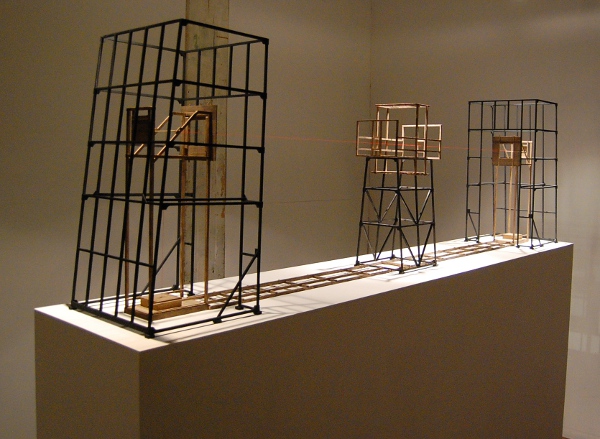
Scott Kip’s “Illuminated Structures” at Marginal Utility
Marginal Utility is displaying the work of Philadelphia-based artist Scott Kip until July 29th as part of his solo exhibit “Illuminated Structures.” The title of the show is somewhat literal, as the entire show consists of a series of tiny architectural creations which stand orderly and neat atop pedestals, bathed in gallery lighting.
These tiny buildings immediately tug at the imagination, but take it into a number of different directions. Anyone with a childhood of playing with Legos, blocks or similar building toys becomes somewhat transported to the days when they would spend hours constructing elaborate, little fortresses.
An individual structure with an interior mirror.
The need to create miniatures exists in a practical way in terms of model-making for actual architectural projects but also a desire to craft small worlds like model train setups. The awe of being so much larger than an entire city has godlike implications, yet also mimics reality in terms of perspective; seeing a skyline from afar, the tallest of skyscrapers appears minute. Simply look at silly photos of tourists holding up the Leaning Tower of Pisa to get an idea of how fun it is to play with scale.
Shadows cast by hidden, ticking gears.
All of the structures appear very industrial in nature. There are no tiny skyscrapers or Eiffel Towers or anything even remotely recognizable. These little scaffolds appear half-built at times or like factories which are meant to fabricate and build, not to exist as ends in and of themselves. The most intriguing part is that no function is clear. They are entirely forms for their own sake. Strips of railroad tracks begin and end beneath a few towers, leading to absolutely nowhere. Strings cross the gaps between buildings and hang taut in the middle of the air. Inside at least one of the structures, watch-like gears tick like a time bomb. They are audible, but relatively hidden aside from the shadows cast by the clicking parts.
While the majority of the pieces are assembled out of wood, some are painted black and give the impression of steel. The occasional mirror gives a glimpse at complicated interior pieces that do not betray their functions. They are like empty factories and the remnants of post-industrial decay without actually appearing dilapidated. In fact, they are quite crisp and precise. Exploring an old warehouse, the functions are often enigmatic to the casual observer or the artist and give way to appreciation of their form instead.
If these creations tell us anything, it is more about ourselves than it is about the rusting industrial facades around us. We look inward to find answers about their origins, but ultimately discover our own architectural inclinations, perspectives, and desires to be bigger than life.
Marginal Utility is located at 319 N. 11th St. (second floor), Philadelphia; marginalutility.org.
Recent Content
-
Artsarticle ·
-
Artsarticle ·
-
Artsarticle ·



